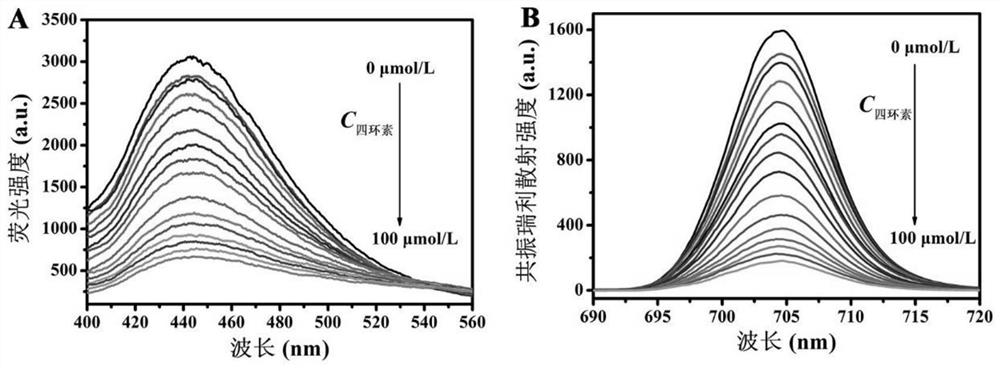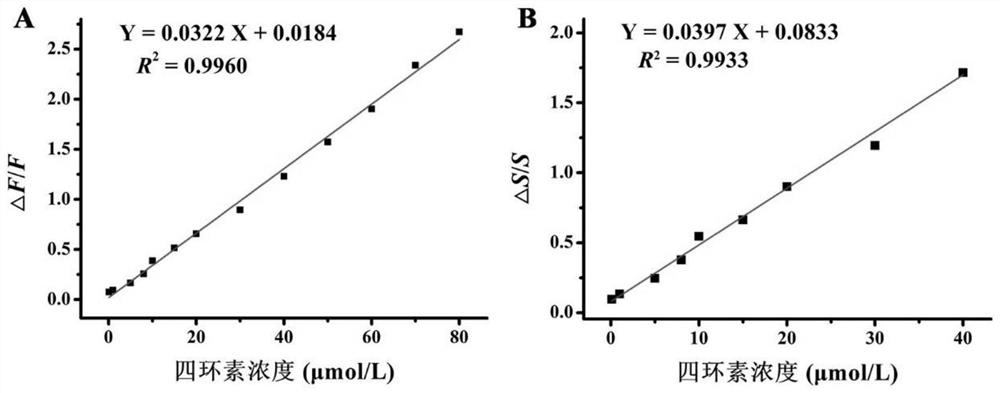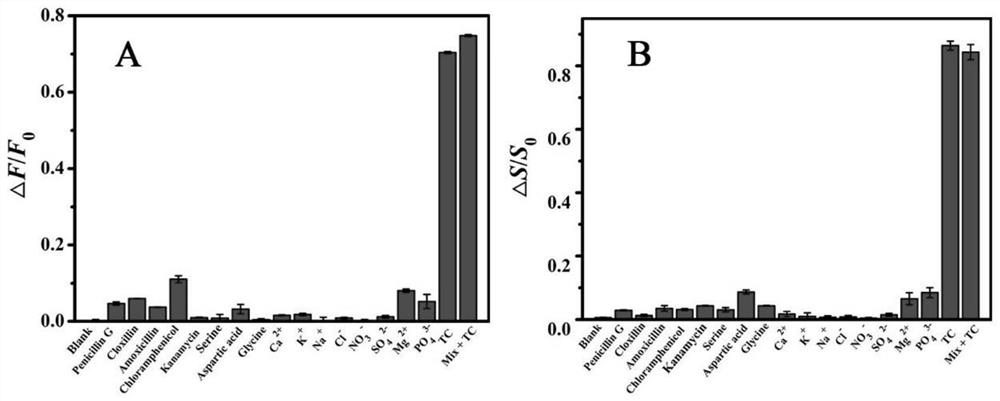Fluorescence and resonance Rayleigh scattering light dual-element signal probe for detecting tetracycline, and preparation method and application thereof
A technology of resonant Rayleigh scattering and signal probes, which is applied in the directions of fluorescence/phosphorescence, chemical instruments and methods, and measurement of scattering characteristics. The process is simple and the effect of controlling food quality and safety
- Summary
- Abstract
- Description
- Claims
- Application Information
AI Technical Summary
Problems solved by technology
Method used
Image
Examples
preparation example Construction
[0031] This application provides a method for preparing a fluorescence and resonance Rayleigh scattered light binary signal probe for detecting tetracycline, including:
[0032] The raw materials including citric acid, ethylenediamine and water are first mixed, heated for the first reaction, and then the first separation is carried out to obtain the carbon dot solution;
[0033] The carbon dot solution, the guanosine monophosphate solution, the cerium nitrate hexahydrate solution and the buffer solution are mixed for the second time, and after the second reaction, the fluorescence and resonance Rayleigh scattered light for detecting tetracycline are obtained through the second separation. Meta signal probe.
[0034] In a preferred embodiment, the first mixing includes: mixing the citric acid, the ethylenediamine and the water until the citric acid is dissolved.
[0035] In a preferred embodiment, the temperature of the first reaction is 150-200°C, and the time is 4-6h.
[00...
Embodiment 1
[0048] This embodiment provides a method for preparing a fluorescent and resonant Rayleigh scattering binary signal probe for detecting tetracycline, which includes the following steps:
[0049] (1) Preparation of carbon dots: Weigh 1.2670 g of citric acid into a beaker, add 1608 μL of ethylenediamine and 30 mL of water to completely dissolve the citric acid. It was then transferred to an autoclave and kept at 200 °C for 5 h. After it was taken out and cooled to room temperature, it was dialyzed with a dialysis bag (1000Da) for 24 hours to obtain a carbon dot solution (0.064mg / mL), and stored at 4°C.
[0050] (2) Preparation of carbon dots@guanosine monophosphate / cerium (CDs@GMP / Ce) probe: Prepare cerium nitrate hexahydrate solution (25mmol / L) and guanosine monophosphate solution (20mmol / L) respectively 10mL, then mix the guanosine monophosphate solution and the carbon dots described in (1) with a magnetic stirrer, then add the prepared cerium nitrate hexahydrate solution int...
Embodiment 2
[0052] This example provides a method for preparing a fluorescent and resonant Rayleigh scattering binary signal probe for the detection of tetracycline. The difference from Example 1 is that the carbon dots are prepared under the condition of 150°C for 6 hours, and the carbon dots The @guanosine monophosphate / cerium (CDs@GMP / Ce) probe was prepared by centrifugation at 8000rpm / min for 10min. It can be understood that the preparation of carbon dots can also be under other temperature and time conditions, and the preparation of carbon dots@guanosine monophosphate / cerium (CDs@GMP / Ce) probes can also be under other centrifugal speed and time conditions.
PUM
 Login to View More
Login to View More Abstract
Description
Claims
Application Information
 Login to View More
Login to View More - Generate Ideas
- Intellectual Property
- Life Sciences
- Materials
- Tech Scout
- Unparalleled Data Quality
- Higher Quality Content
- 60% Fewer Hallucinations
Browse by: Latest US Patents, China's latest patents, Technical Efficacy Thesaurus, Application Domain, Technology Topic, Popular Technical Reports.
© 2025 PatSnap. All rights reserved.Legal|Privacy policy|Modern Slavery Act Transparency Statement|Sitemap|About US| Contact US: help@patsnap.com



